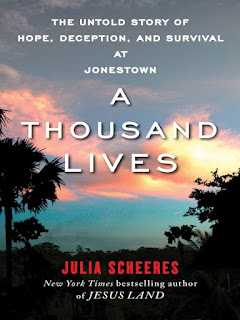By Julia Scheeres
New York, Free Press, 2011
289 pages Religion
A Thousand Lives by Julia Scheeres is the harrowing event by event account of how nearly a thousand people chose to die for an illusory cause in the jungle of a South American country on November 18, 1978. It most definitely is not a book you read for fun, nor is it a book by which you can come to understand the perpetrator, the Rev. Jim Jones. It is a book through which you can gain the follower’s perspective through their writings as well as through the eye-witness accounts of the survivors.
The book contained major surprises for me because I had thought the group was like other wacked-out religious groups. But indeed, this was not the case. At the very beginning, the Rev. Jim Jones had religious intentions; he was a Pentecostal minister. Rather than his religious message, however, it was the sheer force of his personality that brought the people to him. That, and the fact that he believed in total equality of the races, which was a revolutionary idea in the early 1970s. I was fascinated to learn that during the early days of The People’s Temple in San Francisco, the members were active in the political campaigns of Harvey Milk and George Moscone. The ministries of the People’s Temple were social in nature and wide ranging. The followers were believers in social justice and the poor that were being served. The ministry was more socialist than religious.
At some point, Jim Jones began to think of himself not as a preacher, but as God. He began a sermon in 1973 with the words: “For some unexplained set of reasons, I happen to be selected to be God.” The deceit he practiced, including miracles and healings, drew many people to him. He saved many from the streets, clothed them, fed them, sheltered them, and empowered them. He was worshiped for that. “He dangled hope in front of the despondent, and built a ministry around it.”
A grandiose plan emerges to move the entire congregation to the small South American country of Guyana; Jones had wanted to go to Brazil, but they spoke English in Guyana and the government there offered him some land. Eventually a small village called Jonestown was carved out of the jungle, and at the end 1000 people were living there in a hand-to-mouth existence, slaves to a ranting, drug-crazed dictator. He had created an environment where there was nothing left to believe in except Jim Jones. And Jim Jones was plotting a “revolutionary suicide” for them all.
The evolving story is told not through the eyes of Jones, but through the eyes of his followers. Sheeres seems fascinated by the reasons why people become followers of fanatics; she having grown up in a militant Pentecostal group. She brings a unique perspective to the story, which has already been told many times in books and documentaries. The reviewer in the New York Times offers his views as to why Sheeres has narrowed her focus in this way: “What she does not do is give us the why, the context that we long for to explain such an inexplicable tragedy. She does not try to historicize Jim Jones, makes no grand claims that Jonestown represents the final death throes of the 1960s counterculture. In short, she has no comfort for us. One gets the feeling that for Scheeres to step too far outside the walls of the Jonestown compound would feel like a betrayal of those who lost their lives there. So she keeps the focus steady, small and zeroed in on those lives. You will not be able to look away.”
Throughout A Thousand Lives, my rational mind was telling the followers “Just get out of there,” while my sympathetic mind was trying to understand why they stayed. They had been told and idealistically believed that they were being betrayed by society and they had no other alternative than Jim Jones and Jonestown. The Wall Street Journal reviewer says, “Tragically, these idealists embraced death as a final refuge, still unaware that Jones, not society, had betrayed them.” The last few chapters are riveting. I couldn’t put the book down and read with my heart in my throat, even though I knew what was going to happen to these idealistic, misguided people and their poor innocent children. They will all “drink the Koolaid.”
There is a vast amount of information on Julia Scheere’s website, including videos and lots of pictures. I recommend you search the website for an even greater understanding: http://juliascheeres.com.
The New York Times review: http://www.nytimes.com/2011/10/09/books/review/a-thousand-lives-by-julia-scheeres-book-review.html
The Wall Street Journal review: http://online.wsj.com/articleSB10001424052970204524604576610832315287222.html




No comments:
Post a Comment